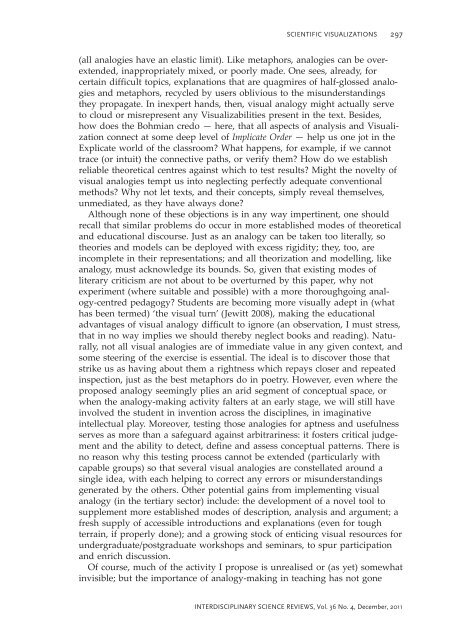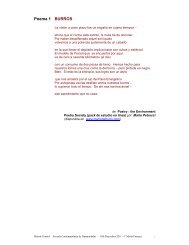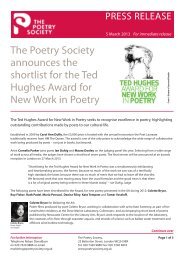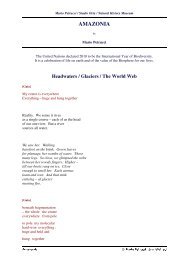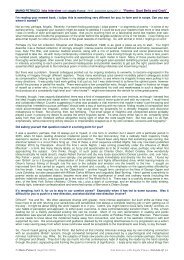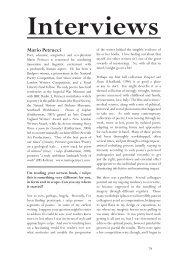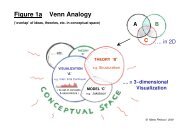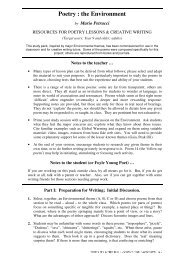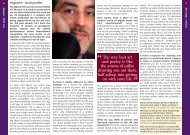Scientific Visualizations: Bridge-Building between ... - Mario Petrucci
Scientific Visualizations: Bridge-Building between ... - Mario Petrucci
Scientific Visualizations: Bridge-Building between ... - Mario Petrucci
Create successful ePaper yourself
Turn your PDF publications into a flip-book with our unique Google optimized e-Paper software.
SCIENTIFIC VISUALIZATIONS<br />
297<br />
(all analogies have an elastic limit). Like metaphors, analogies can be overextended,<br />
inappropriately mixed, or poorly made. One sees, already, for<br />
certain difficult topics, explanations that are quagmires of half-glossed analogies<br />
and metaphors, recycled by users oblivious to the misunderstandings<br />
they propagate. In inexpert hands, then, visual analogy might actually serve<br />
to cloud or misrepresent any Visualizabilities present in the text. Besides,<br />
how does the Bohmian credo — here, that all aspects of analysis and Visualization<br />
connect at some deep level of Implicate Order — help us one jot in the<br />
Explicate world of the classroom? What happens, for example, if we cannot<br />
trace (or intuit) the connective paths, or verify them? How do we establish<br />
reliable theoretical centres against which to test results? Might the novelty of<br />
visual analogies tempt us into neglecting perfectly adequate conventional<br />
methods? Why not let texts, and their concepts, simply reveal themselves,<br />
unmediated, as they have always done?<br />
Although none of these objections is in any way impertinent, one should<br />
recall that similar problems do occur in more established modes of theoretical<br />
and educational discourse. Just as an analogy can be taken too literally, so<br />
theories and models can be deployed with excess rigidity; they, too, are<br />
incomplete in their representations; and all theorization and modelling, like<br />
analogy, must acknowledge its bounds. So, given that existing modes of<br />
literary criticism are not about to be overturned by this paper, why not<br />
experiment (where suitable and possible) with a more thoroughgoing analogy-centred<br />
pedagogy? Students are becoming more visually adept in (what<br />
has been termed) ‘the visual turn’ (Jewitt 2008), making the educational<br />
advantages of visual analogy difficult to ignore (an observation, I must stress,<br />
that in no way implies we should thereby neglect books and reading). Naturally,<br />
not all visual analogies are of immediate value in any given context, and<br />
some steering of the exercise is essential. The ideal is to discover those that<br />
strike us as having about them a rightness which repays closer and repeated<br />
inspection, just as the best metaphors do in poetry. However, even where the<br />
proposed analogy seemingly plies an arid segment of conceptual space, or<br />
when the analogy-making activity falters at an early stage, we will still have<br />
involved the student in invention across the disciplines, in imaginative<br />
intellectual play. Moreover, testing those analogies for aptness and usefulness<br />
serves as more than a safeguard against arbitrariness: it fosters critical judgement<br />
and the ability to detect, define and assess conceptual patterns. There is<br />
no reason why this testing process cannot be extended (particularly with<br />
capable groups) so that several visual analogies are constellated around a<br />
single idea, with each helping to correct any errors or misunderstandings<br />
generated by the others. Other potential gains from implementing visual<br />
analogy (in the tertiary sector) include: the development of a novel tool to<br />
supplement more established modes of description, analysis and argument; a<br />
fresh supply of accessible introductions and explanations (even for tough<br />
terrain, if properly done); and a growing stock of enticing visual resources for<br />
undergraduate/postgraduate workshops and seminars, to spur participation<br />
and enrich discussion.<br />
Of course, much of the activity I propose is unrealised or (as yet) somewhat<br />
invisible; but the importance of analogy-making in teaching has not gone<br />
INTERDISCIPLINARY SCIENCE REVIEWS, Vol. 36 No. 4, December, 2011


